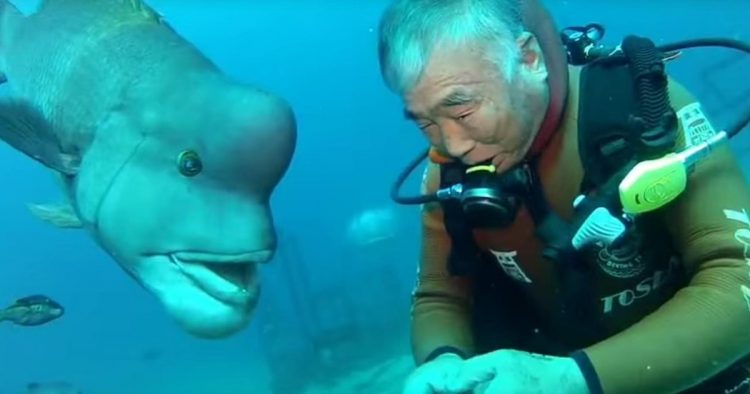The Unlikely 25-Year Friendship Between a Human Diver and a Fish

Tateyama Bay, in Japan’s Chiba Prefecture, is the meeting place of two very unlikely friends – local diver Hiroyuki Arakawa and an Asian sheepshead wrasse by the name of Yoriko. The pair met 25 years ago and have been visiting each other ever since. Arakawa has been looking after an underwater Shinto shrine located in Tateyama Bay […]
Man Builds Awe-Inspiring Home Reef Aquarium Large Enough to Scuba Dive in

Eli Fruchter, an aquarium enthusiast from Haifa, Israel, is one of the few people in the world who can swim in his living room surrounded by brightly-colored tropical fish. He is the owner of the largest home reef aquarium in Israel, and probably the world. For as long as he can remember, Eli loved aquariums. When […]
Russian Makeup Artist Sparks Outrage after Using Real Fish as Facial Accessories
It’s hard to imagine how putting dead fish on your face can pass off as make up, but that didn’t stop Russian makeup artist Elya Bulochka using them as facial accessories for a marine-themed photo shoot. Her original idea, however, sparked a deluge of criticism and outrage on Instagram for what is being viewed as a highly insensitive […]
Gyotaku – The Traditional Japanese Art of Painting Fish with Actual Fish
Back when there were no cameras for fishermen to record their trophy catches, the Japanese came up with a unique printing method called Gyotaku. Gyo means fish, and Taku means impression, and the technique involved just that – using freshly caught fish to make inky impressions on paper. Hundreds of years ago, Japanese fishermen would […]
Colorado Lake Becomes Giant Fish Bowl after Dumped Goldfish Multiply by the Thousands

Releasing pet fish into a lake might sound like a kind thing to do, but in fact, it is quite the opposite. Teller Lake in Boulder, Colorado, is making headlines for a bizarre surge in its goldfish population, after someone apparently dumped three or four of them in its waters a couple of years ago. […]
Man Pays $460 for Surgery to Save Life of Constipated Pet Fish

A devoted pet owner in England recently spent nearly $500 on a complicated surgery to save the life of his favorite goldfish. The unnamed man rushed his fish to the Toll Barn Veterinary Centre in Norfolk, when he noticed that it was struggling to eliminate waste. After a thorough examination, the staff at the center […]
Tiny Fish Can Pick Up 300 Times Its Own Body Weight

The northern clingfish is a species of salt-water fish that truly lives up to its name. The remarkably strong fish has such high suction powers that it can pick up and hold on to stuff that’s almost 300 times its own body weight. It can easily outperform all sorts of man-made suction cups. Scientists are […]
Korea’s Most Popular Fermented Fish Dish Smells Like a Public Toilet

Fermented foods aren’t exactly famous for their alluring smell and flavor, but South Korea’s popular ‘hongeo’ has just got to be the worst of the lot. It’s definitely classified as one of the grossest foods in the world, even for ‘foodie daredevils’ who like trying out weird dishes. What makes hongeo so bad? Well, for starters, […]
Behold the Aquatic Perambulator – A Device That Lets You Take Your Fish for a Walk

Seven years ago, when Mike Warren-Madden worried that his pet fish Malcolm was getting bored, he decided to do something about it. He spent weeks at the drawing board, designing a unique device – an Aquatic Perambulator – that would allow him to take his fish for a walk. The pram helped Malcolm live a […]
Large School of Fish Frozen in Place near the Coast of Norway

This winter’s been a rough one so far. There are so many pictures online of frozen cities and towns. The season has been bad for Canada and the US, due to the much discussed polar vortex. The UK is said to be facing the worst winter in decades. The extreme temperatures have been keeping people […]
Unique Archerfish Spits Jets of Water to Shoot Down Its Prey

The water-pistol is a harmless toy for children, but apparently it can be a lethal weapon too. This particular species of fish makes use of water jets and the laws of physics to aim at and stun its prey. The aptly named archerfish employs a unique process to hunt land based insects and small animals […]
The Pacific Barreleye Fish and Its Weird See-Through Head

The Pacific Barreleye fish gets its name from large eyes that are literally shaped like barrels, topped with beautiful green lenses. Also known as the Macropinna microstoma, its head is completely transparent, filled with fluid. This unique creature lives at depths of around 2000 to 2,600 ft. The Pacific Barreleye’s see-through head may seem weird, […]
These Fish Are So Delicious You’ll Soil Yourself, Literally

Buttery and succulent, the related oil fish (Ruvettus pretiosus) and escolar (Lepidocybium flavobrunneum)) are considered to be two of the most palatable fish in the world. But before you run out to your local fish market in search of these delicacies, you’d better stock up on toilet paper because you’re going to spend a lot of […]
The Ocellated Ice Fish – World’s Only Vertebrate with Transparent Blood

Every animal with bones hemoglobin in its blood, which carries oxygen through its body and gives blood its red color. Every animal except one – the ocellated ice fish which has water-clear blood. The ocean’s depth have revealed a series of odd life forms in recent years, from giant squid to translucent sea anemones, but […]
Japanese Fisherman-Turned-Artist Creates Skeletal Artworks from Dead Animals

Believe it or not, the Japanese use fish for something else than sushi. Take Iori Tomita, a former fisherman who now creates creepy works of art from various dead marine specimens. 28-year-old Iori Tomita uses scientific techniques of preserving and dyeing to transform dead fish into brightly-colored glowing pieces of art. The former fisherman applies over 10 different […]
